Organizational Behavior: Culture, Politics, Power, and Motivation
VerifiedAdded on 2023/02/02
|11
|2245
|29
AI Summary
This document explores the influence of culture, politics, power, and motivation on individual and team behavior and performance in BusabaEathai, a restaurant in London. It discusses content and process theories of motivation and explains the characteristics of effective teams. The document also covers organizational concepts and philosophies.
Contribute Materials
Your contribution can guide someone’s learning journey. Share your
documents today.
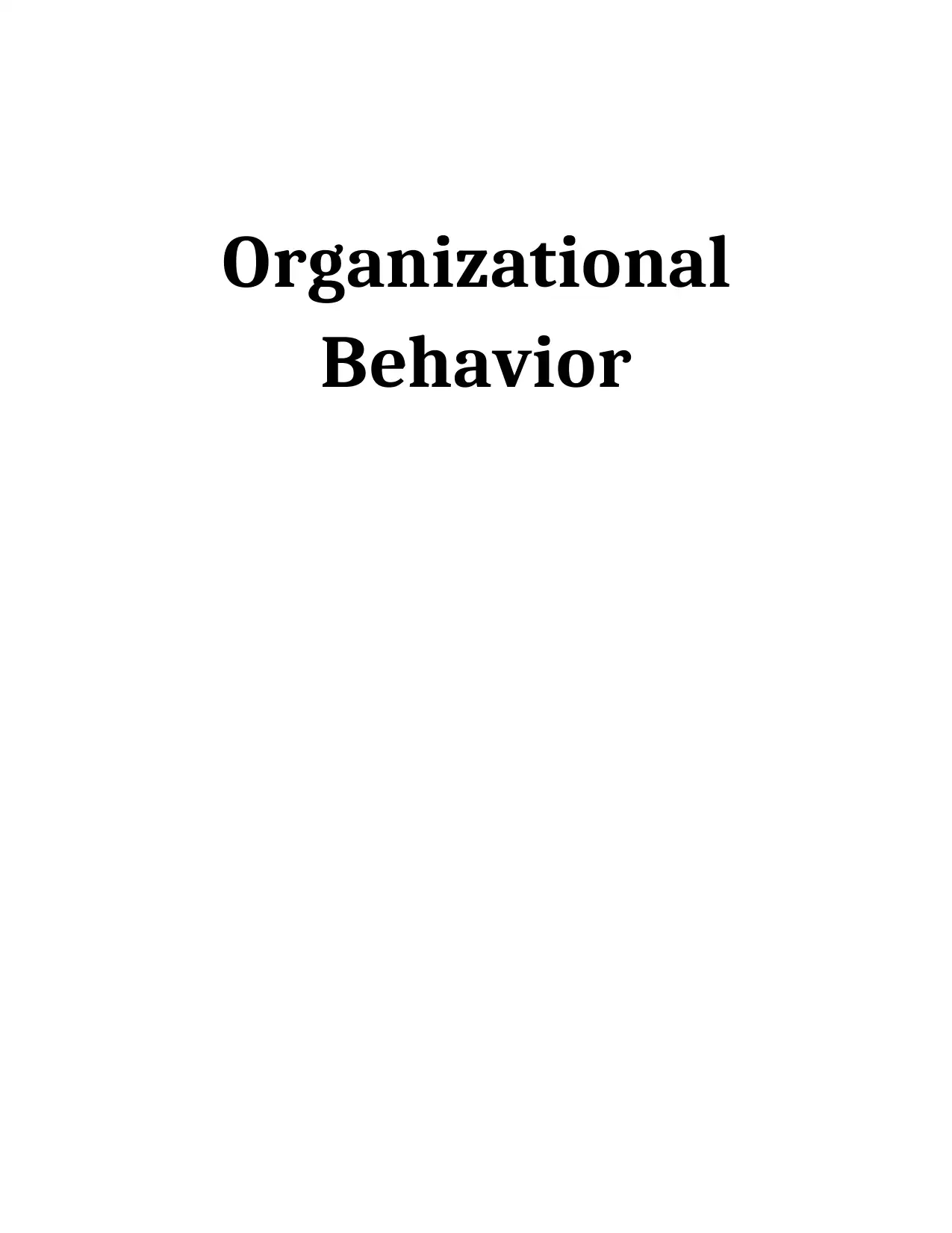
Organizational
Behavior
Behavior
Secure Best Marks with AI Grader
Need help grading? Try our AI Grader for instant feedback on your assignments.
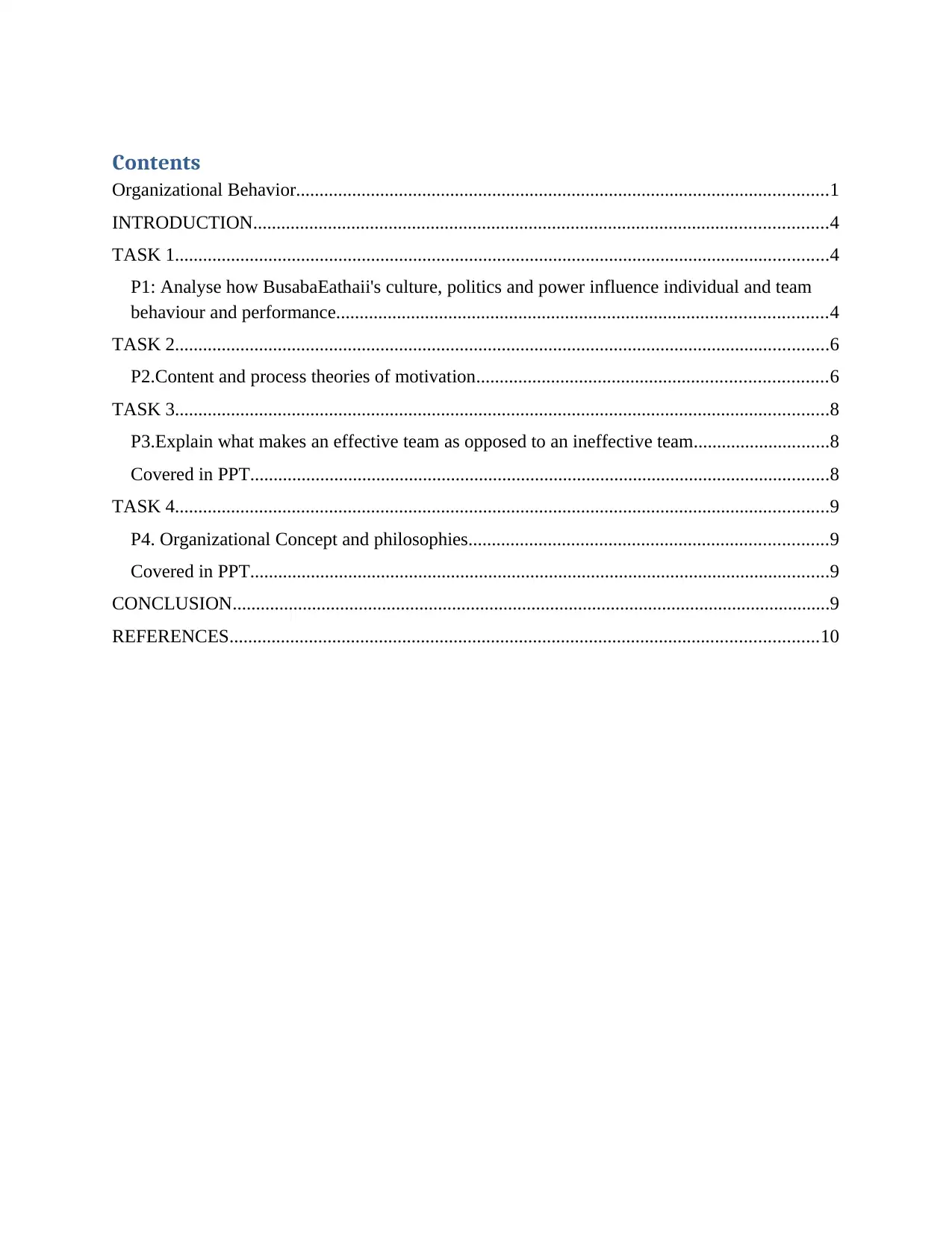
Contents
Organizational Behavior..................................................................................................................1
INTRODUCTION...........................................................................................................................4
TASK 1............................................................................................................................................4
P1: Analyse how BusabaEathaii's culture, politics and power influence individual and team
behaviour and performance.........................................................................................................4
TASK 2............................................................................................................................................6
P2.Content and process theories of motivation...........................................................................6
TASK 3............................................................................................................................................8
P3.Explain what makes an effective team as opposed to an ineffective team.............................8
Covered in PPT............................................................................................................................8
TASK 4............................................................................................................................................9
P4. Organizational Concept and philosophies.............................................................................9
Covered in PPT............................................................................................................................9
CONCLUSION................................................................................................................................9
REFERENCES..............................................................................................................................10
Organizational Behavior..................................................................................................................1
INTRODUCTION...........................................................................................................................4
TASK 1............................................................................................................................................4
P1: Analyse how BusabaEathaii's culture, politics and power influence individual and team
behaviour and performance.........................................................................................................4
TASK 2............................................................................................................................................6
P2.Content and process theories of motivation...........................................................................6
TASK 3............................................................................................................................................8
P3.Explain what makes an effective team as opposed to an ineffective team.............................8
Covered in PPT............................................................................................................................8
TASK 4............................................................................................................................................9
P4. Organizational Concept and philosophies.............................................................................9
Covered in PPT............................................................................................................................9
CONCLUSION................................................................................................................................9
REFERENCES..............................................................................................................................10

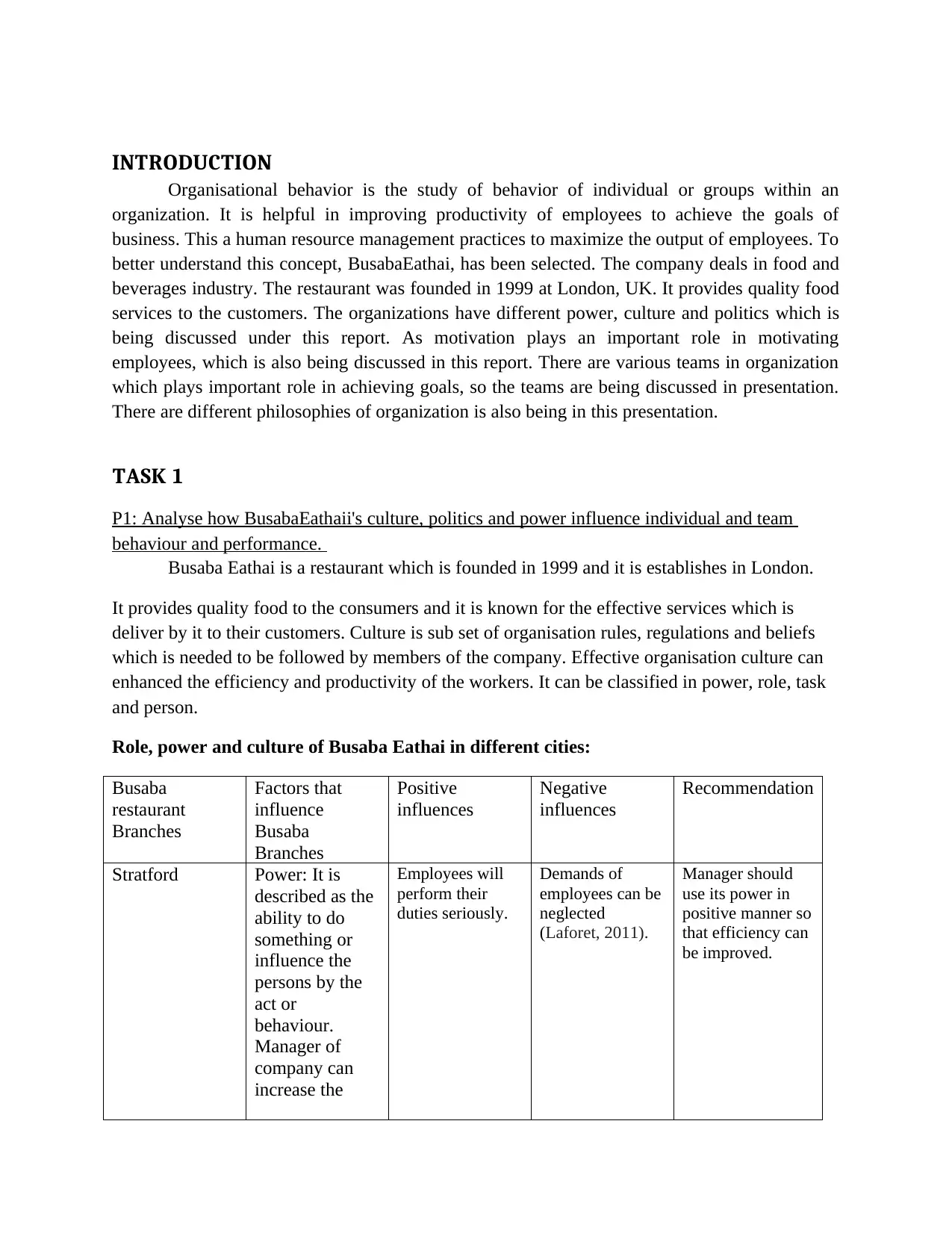
INTRODUCTION
Organisational behavior is the study of behavior of individual or groups within an
organization. It is helpful in improving productivity of employees to achieve the goals of
business. This a human resource management practices to maximize the output of employees. To
better understand this concept, BusabaEathai, has been selected. The company deals in food and
beverages industry. The restaurant was founded in 1999 at London, UK. It provides quality food
services to the customers. The organizations have different power, culture and politics which is
being discussed under this report. As motivation plays an important role in motivating
employees, which is also being discussed in this report. There are various teams in organization
which plays important role in achieving goals, so the teams are being discussed in presentation.
There are different philosophies of organization is also being in this presentation.
TASK 1
P1: Analyse how BusabaEathaii's culture, politics and power influence individual and team
behaviour and performance.
Busaba Eathai is a restaurant which is founded in 1999 and it is establishes in London.
It provides quality food to the consumers and it is known for the effective services which is
deliver by it to their customers. Culture is sub set of organisation rules, regulations and beliefs
which is needed to be followed by members of the company. Effective organisation culture can
enhanced the efficiency and productivity of the workers. It can be classified in power, role, task
and person.
Role, power and culture of Busaba Eathai in different cities:
Busaba
restaurant
Branches
Factors that
influence
Busaba
Branches
Positive
influences
Negative
influences
Recommendation
Stratford Power: It is
described as the
ability to do
something or
influence the
persons by the
act or
behaviour.
Manager of
company can
increase the
Employees will
perform their
duties seriously.
Demands of
employees can be
neglected
(Laforet, 2011).
Manager should
use its power in
positive manner so
that efficiency can
be improved.
Organisational behavior is the study of behavior of individual or groups within an
organization. It is helpful in improving productivity of employees to achieve the goals of
business. This a human resource management practices to maximize the output of employees. To
better understand this concept, BusabaEathai, has been selected. The company deals in food and
beverages industry. The restaurant was founded in 1999 at London, UK. It provides quality food
services to the customers. The organizations have different power, culture and politics which is
being discussed under this report. As motivation plays an important role in motivating
employees, which is also being discussed in this report. There are various teams in organization
which plays important role in achieving goals, so the teams are being discussed in presentation.
There are different philosophies of organization is also being in this presentation.
TASK 1
P1: Analyse how BusabaEathaii's culture, politics and power influence individual and team
behaviour and performance.
Busaba Eathai is a restaurant which is founded in 1999 and it is establishes in London.
It provides quality food to the consumers and it is known for the effective services which is
deliver by it to their customers. Culture is sub set of organisation rules, regulations and beliefs
which is needed to be followed by members of the company. Effective organisation culture can
enhanced the efficiency and productivity of the workers. It can be classified in power, role, task
and person.
Role, power and culture of Busaba Eathai in different cities:
Busaba
restaurant
Branches
Factors that
influence
Busaba
Branches
Positive
influences
Negative
influences
Recommendation
Stratford Power: It is
described as the
ability to do
something or
influence the
persons by the
act or
behaviour.
Manager of
company can
increase the
Employees will
perform their
duties seriously.
Demands of
employees can be
neglected
(Laforet, 2011).
Manager should
use its power in
positive manner so
that efficiency can
be improved.
Secure Best Marks with AI Grader
Need help grading? Try our AI Grader for instant feedback on your assignments.
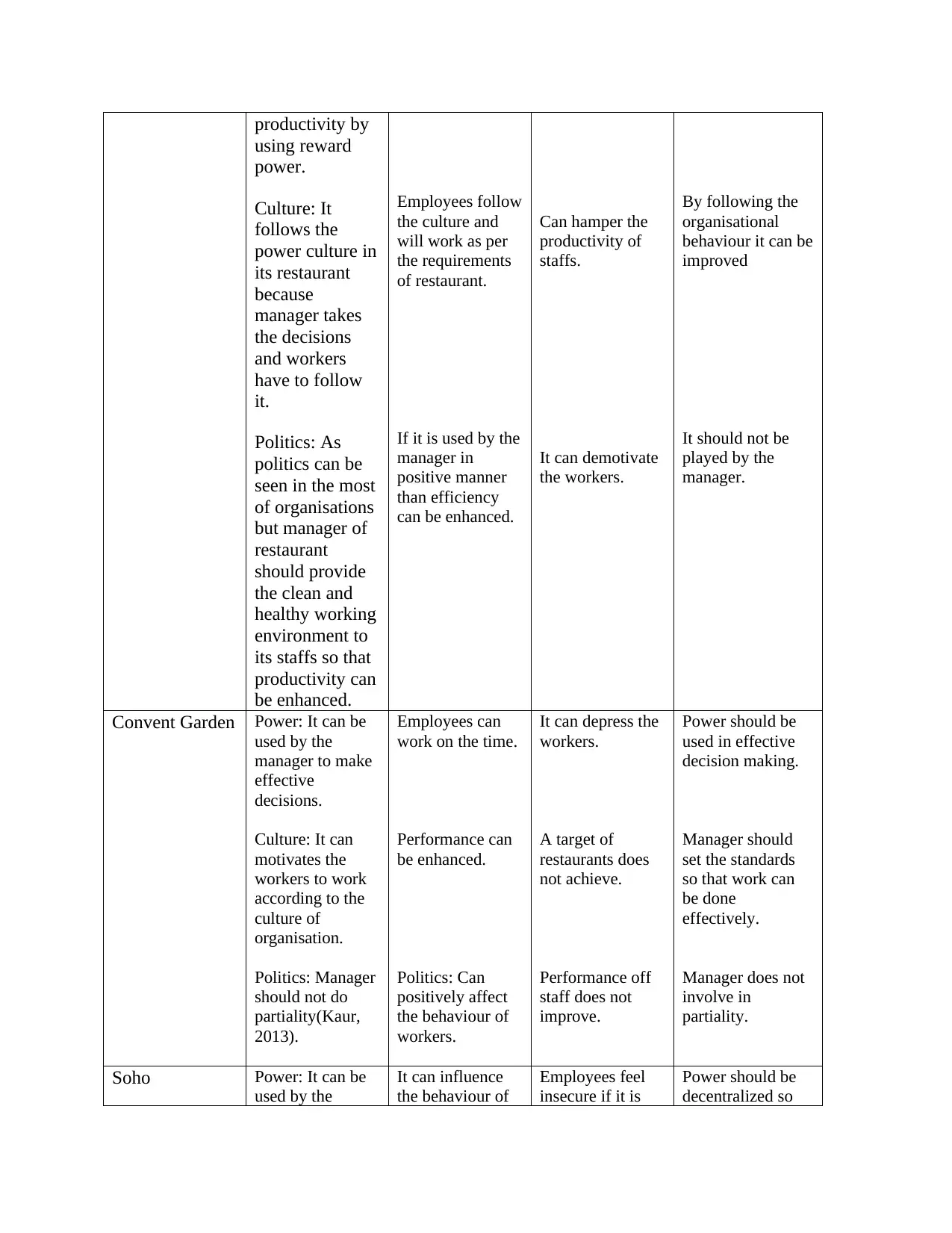
productivity by
using reward
power.
Culture: It
follows the
power culture in
its restaurant
because
manager takes
the decisions
and workers
have to follow
it.
Politics: As
politics can be
seen in the most
of organisations
but manager of
restaurant
should provide
the clean and
healthy working
environment to
its staffs so that
productivity can
be enhanced.
Employees follow
the culture and
will work as per
the requirements
of restaurant.
If it is used by the
manager in
positive manner
than efficiency
can be enhanced.
Can hamper the
productivity of
staffs.
It can demotivate
the workers.
By following the
organisational
behaviour it can be
improved
It should not be
played by the
manager.
Convent Garden Power: It can be
used by the
manager to make
effective
decisions.
Culture: It can
motivates the
workers to work
according to the
culture of
organisation.
Politics: Manager
should not do
partiality(Kaur,
2013).
Employees can
work on the time.
Performance can
be enhanced.
Politics: Can
positively affect
the behaviour of
workers.
It can depress the
workers.
A target of
restaurants does
not achieve.
Performance off
staff does not
improve.
Power should be
used in effective
decision making.
Manager should
set the standards
so that work can
be done
effectively.
Manager does not
involve in
partiality.
Soho Power: It can be
used by the
It can influence
the behaviour of
Employees feel
insecure if it is
Power should be
decentralized so
using reward
power.
Culture: It
follows the
power culture in
its restaurant
because
manager takes
the decisions
and workers
have to follow
it.
Politics: As
politics can be
seen in the most
of organisations
but manager of
restaurant
should provide
the clean and
healthy working
environment to
its staffs so that
productivity can
be enhanced.
Employees follow
the culture and
will work as per
the requirements
of restaurant.
If it is used by the
manager in
positive manner
than efficiency
can be enhanced.
Can hamper the
productivity of
staffs.
It can demotivate
the workers.
By following the
organisational
behaviour it can be
improved
It should not be
played by the
manager.
Convent Garden Power: It can be
used by the
manager to make
effective
decisions.
Culture: It can
motivates the
workers to work
according to the
culture of
organisation.
Politics: Manager
should not do
partiality(Kaur,
2013).
Employees can
work on the time.
Performance can
be enhanced.
Politics: Can
positively affect
the behaviour of
workers.
It can depress the
workers.
A target of
restaurants does
not achieve.
Performance off
staff does not
improve.
Power should be
used in effective
decision making.
Manager should
set the standards
so that work can
be done
effectively.
Manager does not
involve in
partiality.
Soho Power: It can be
used by the
It can influence
the behaviour of
Employees feel
insecure if it is
Power should be
decentralized so
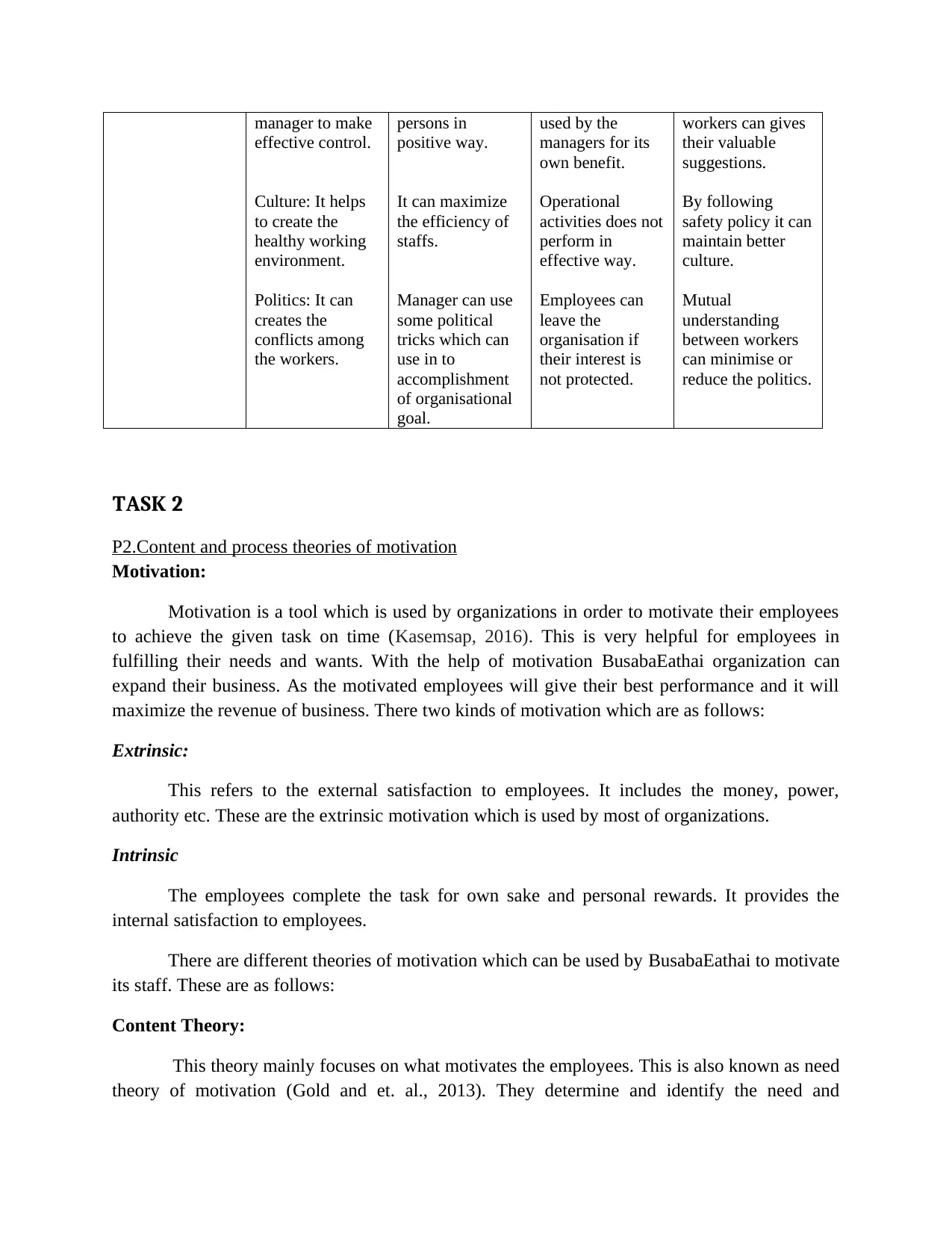
manager to make
effective control.
Culture: It helps
to create the
healthy working
environment.
Politics: It can
creates the
conflicts among
the workers.
persons in
positive way.
It can maximize
the efficiency of
staffs.
Manager can use
some political
tricks which can
use in to
accomplishment
of organisational
goal.
used by the
managers for its
own benefit.
Operational
activities does not
perform in
effective way.
Employees can
leave the
organisation if
their interest is
not protected.
workers can gives
their valuable
suggestions.
By following
safety policy it can
maintain better
culture.
Mutual
understanding
between workers
can minimise or
reduce the politics.
TASK 2
P2.Content and process theories of motivation
Motivation:
Motivation is a tool which is used by organizations in order to motivate their employees
to achieve the given task on time (Kasemsap, 2016). This is very helpful for employees in
fulfilling their needs and wants. With the help of motivation BusabaEathai organization can
expand their business. As the motivated employees will give their best performance and it will
maximize the revenue of business. There two kinds of motivation which are as follows:
Extrinsic:
This refers to the external satisfaction to employees. It includes the money, power,
authority etc. These are the extrinsic motivation which is used by most of organizations.
Intrinsic
The employees complete the task for own sake and personal rewards. It provides the
internal satisfaction to employees.
There are different theories of motivation which can be used by BusabaEathai to motivate
its staff. These are as follows:
Content Theory:
This theory mainly focuses on what motivates the employees. This is also known as need
theory of motivation (Gold and et. al., 2013). They determine and identify the need and
effective control.
Culture: It helps
to create the
healthy working
environment.
Politics: It can
creates the
conflicts among
the workers.
persons in
positive way.
It can maximize
the efficiency of
staffs.
Manager can use
some political
tricks which can
use in to
accomplishment
of organisational
goal.
used by the
managers for its
own benefit.
Operational
activities does not
perform in
effective way.
Employees can
leave the
organisation if
their interest is
not protected.
workers can gives
their valuable
suggestions.
By following
safety policy it can
maintain better
culture.
Mutual
understanding
between workers
can minimise or
reduce the politics.
TASK 2
P2.Content and process theories of motivation
Motivation:
Motivation is a tool which is used by organizations in order to motivate their employees
to achieve the given task on time (Kasemsap, 2016). This is very helpful for employees in
fulfilling their needs and wants. With the help of motivation BusabaEathai organization can
expand their business. As the motivated employees will give their best performance and it will
maximize the revenue of business. There two kinds of motivation which are as follows:
Extrinsic:
This refers to the external satisfaction to employees. It includes the money, power,
authority etc. These are the extrinsic motivation which is used by most of organizations.
Intrinsic
The employees complete the task for own sake and personal rewards. It provides the
internal satisfaction to employees.
There are different theories of motivation which can be used by BusabaEathai to motivate
its staff. These are as follows:
Content Theory:
This theory mainly focuses on what motivates the employees. This is also known as need
theory of motivation (Gold and et. al., 2013). They determine and identify the need and
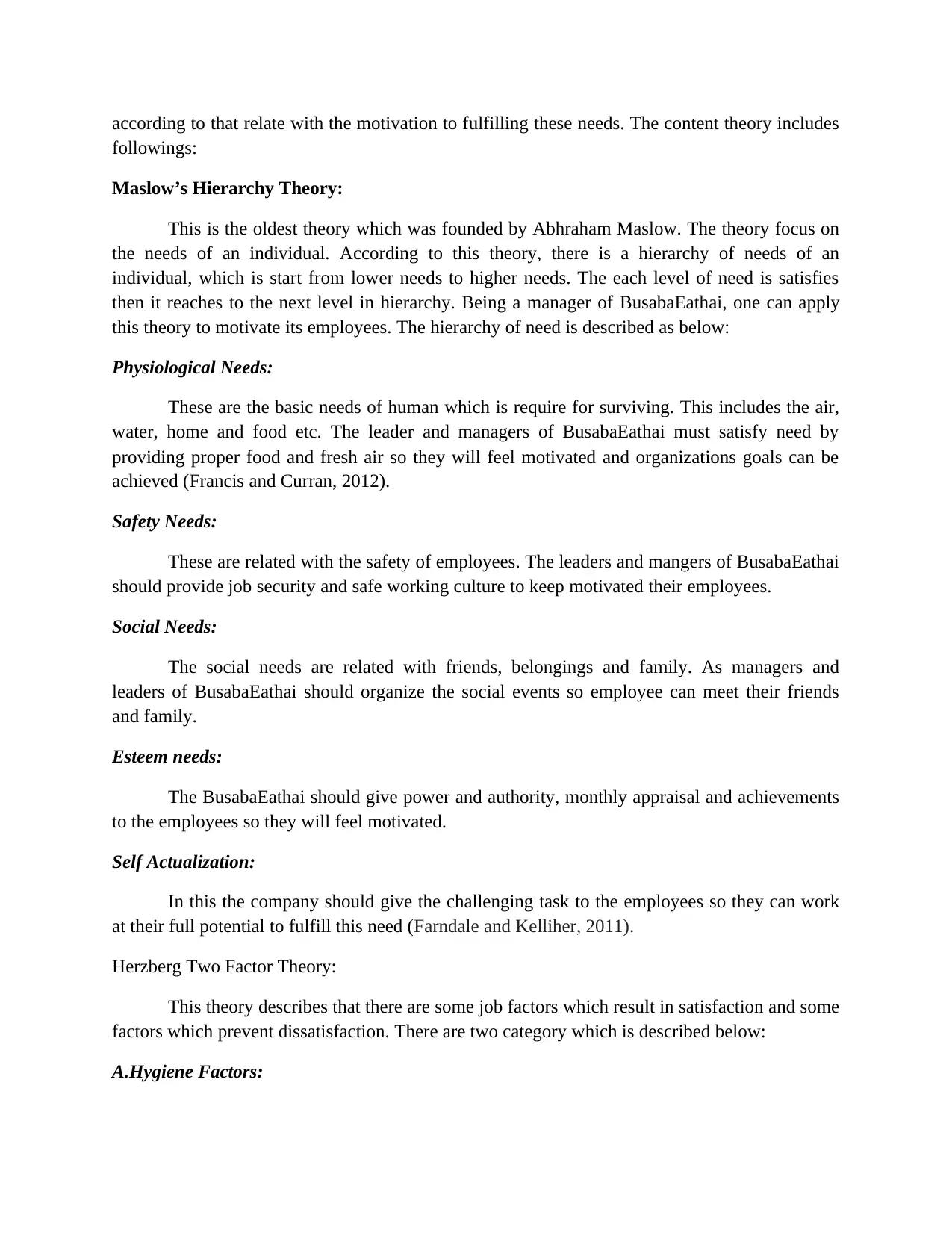
according to that relate with the motivation to fulfilling these needs. The content theory includes
followings:
Maslow’s Hierarchy Theory:
This is the oldest theory which was founded by Abhraham Maslow. The theory focus on
the needs of an individual. According to this theory, there is a hierarchy of needs of an
individual, which is start from lower needs to higher needs. The each level of need is satisfies
then it reaches to the next level in hierarchy. Being a manager of BusabaEathai, one can apply
this theory to motivate its employees. The hierarchy of need is described as below:
Physiological Needs:
These are the basic needs of human which is require for surviving. This includes the air,
water, home and food etc. The leader and managers of BusabaEathai must satisfy need by
providing proper food and fresh air so they will feel motivated and organizations goals can be
achieved (Francis and Curran, 2012).
Safety Needs:
These are related with the safety of employees. The leaders and mangers of BusabaEathai
should provide job security and safe working culture to keep motivated their employees.
Social Needs:
The social needs are related with friends, belongings and family. As managers and
leaders of BusabaEathai should organize the social events so employee can meet their friends
and family.
Esteem needs:
The BusabaEathai should give power and authority, monthly appraisal and achievements
to the employees so they will feel motivated.
Self Actualization:
In this the company should give the challenging task to the employees so they can work
at their full potential to fulfill this need (Farndale and Kelliher, 2011).
Herzberg Two Factor Theory:
This theory describes that there are some job factors which result in satisfaction and some
factors which prevent dissatisfaction. There are two category which is described below:
A.Hygiene Factors:
followings:
Maslow’s Hierarchy Theory:
This is the oldest theory which was founded by Abhraham Maslow. The theory focus on
the needs of an individual. According to this theory, there is a hierarchy of needs of an
individual, which is start from lower needs to higher needs. The each level of need is satisfies
then it reaches to the next level in hierarchy. Being a manager of BusabaEathai, one can apply
this theory to motivate its employees. The hierarchy of need is described as below:
Physiological Needs:
These are the basic needs of human which is require for surviving. This includes the air,
water, home and food etc. The leader and managers of BusabaEathai must satisfy need by
providing proper food and fresh air so they will feel motivated and organizations goals can be
achieved (Francis and Curran, 2012).
Safety Needs:
These are related with the safety of employees. The leaders and mangers of BusabaEathai
should provide job security and safe working culture to keep motivated their employees.
Social Needs:
The social needs are related with friends, belongings and family. As managers and
leaders of BusabaEathai should organize the social events so employee can meet their friends
and family.
Esteem needs:
The BusabaEathai should give power and authority, monthly appraisal and achievements
to the employees so they will feel motivated.
Self Actualization:
In this the company should give the challenging task to the employees so they can work
at their full potential to fulfill this need (Farndale and Kelliher, 2011).
Herzberg Two Factor Theory:
This theory describes that there are some job factors which result in satisfaction and some
factors which prevent dissatisfaction. There are two category which is described below:
A.Hygiene Factors:
Paraphrase This Document
Need a fresh take? Get an instant paraphrase of this document with our AI Paraphraser
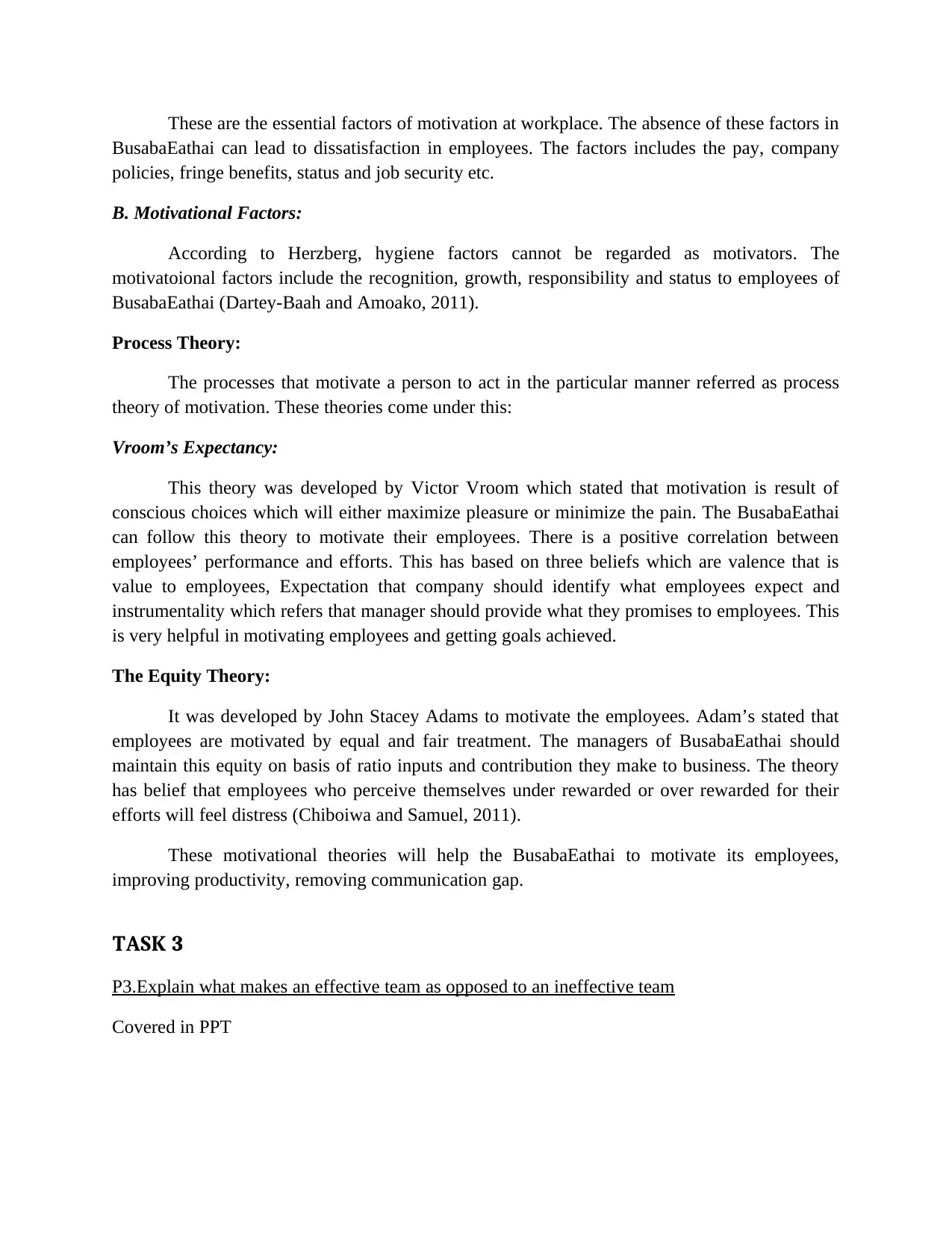
These are the essential factors of motivation at workplace. The absence of these factors in
BusabaEathai can lead to dissatisfaction in employees. The factors includes the pay, company
policies, fringe benefits, status and job security etc.
B. Motivational Factors:
According to Herzberg, hygiene factors cannot be regarded as motivators. The
motivatoional factors include the recognition, growth, responsibility and status to employees of
BusabaEathai (Dartey-Baah and Amoako, 2011).
Process Theory:
The processes that motivate a person to act in the particular manner referred as process
theory of motivation. These theories come under this:
Vroom’s Expectancy:
This theory was developed by Victor Vroom which stated that motivation is result of
conscious choices which will either maximize pleasure or minimize the pain. The BusabaEathai
can follow this theory to motivate their employees. There is a positive correlation between
employees’ performance and efforts. This has based on three beliefs which are valence that is
value to employees, Expectation that company should identify what employees expect and
instrumentality which refers that manager should provide what they promises to employees. This
is very helpful in motivating employees and getting goals achieved.
The Equity Theory:
It was developed by John Stacey Adams to motivate the employees. Adam’s stated that
employees are motivated by equal and fair treatment. The managers of BusabaEathai should
maintain this equity on basis of ratio inputs and contribution they make to business. The theory
has belief that employees who perceive themselves under rewarded or over rewarded for their
efforts will feel distress (Chiboiwa and Samuel, 2011).
These motivational theories will help the BusabaEathai to motivate its employees,
improving productivity, removing communication gap.
TASK 3
P3.Explain what makes an effective team as opposed to an ineffective team
Covered in PPT
BusabaEathai can lead to dissatisfaction in employees. The factors includes the pay, company
policies, fringe benefits, status and job security etc.
B. Motivational Factors:
According to Herzberg, hygiene factors cannot be regarded as motivators. The
motivatoional factors include the recognition, growth, responsibility and status to employees of
BusabaEathai (Dartey-Baah and Amoako, 2011).
Process Theory:
The processes that motivate a person to act in the particular manner referred as process
theory of motivation. These theories come under this:
Vroom’s Expectancy:
This theory was developed by Victor Vroom which stated that motivation is result of
conscious choices which will either maximize pleasure or minimize the pain. The BusabaEathai
can follow this theory to motivate their employees. There is a positive correlation between
employees’ performance and efforts. This has based on three beliefs which are valence that is
value to employees, Expectation that company should identify what employees expect and
instrumentality which refers that manager should provide what they promises to employees. This
is very helpful in motivating employees and getting goals achieved.
The Equity Theory:
It was developed by John Stacey Adams to motivate the employees. Adam’s stated that
employees are motivated by equal and fair treatment. The managers of BusabaEathai should
maintain this equity on basis of ratio inputs and contribution they make to business. The theory
has belief that employees who perceive themselves under rewarded or over rewarded for their
efforts will feel distress (Chiboiwa and Samuel, 2011).
These motivational theories will help the BusabaEathai to motivate its employees,
improving productivity, removing communication gap.
TASK 3
P3.Explain what makes an effective team as opposed to an ineffective team
Covered in PPT
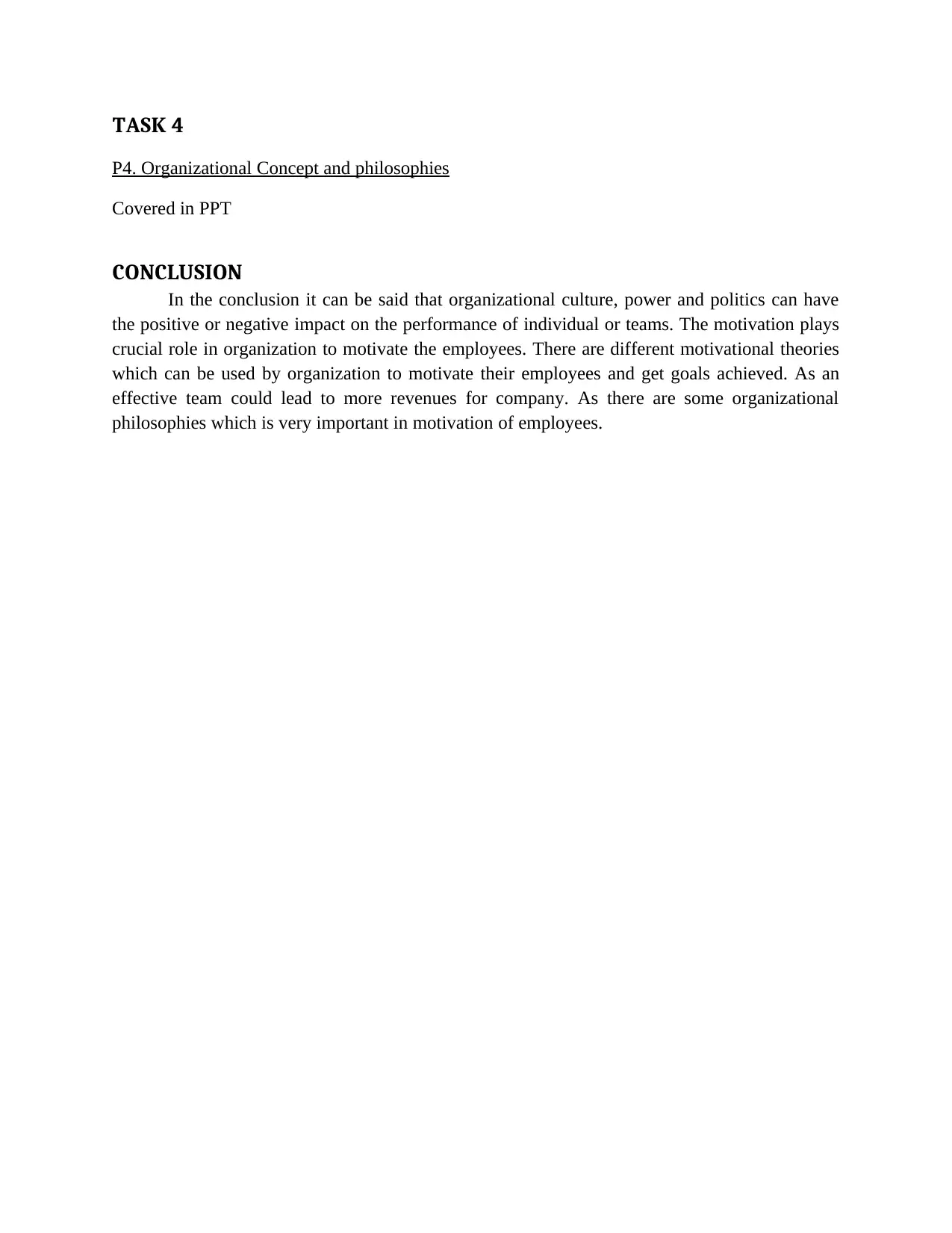
TASK 4
P4. Organizational Concept and philosophies
Covered in PPT
CONCLUSION
In the conclusion it can be said that organizational culture, power and politics can have
the positive or negative impact on the performance of individual or teams. The motivation plays
crucial role in organization to motivate the employees. There are different motivational theories
which can be used by organization to motivate their employees and get goals achieved. As an
effective team could lead to more revenues for company. As there are some organizational
philosophies which is very important in motivation of employees.
P4. Organizational Concept and philosophies
Covered in PPT
CONCLUSION
In the conclusion it can be said that organizational culture, power and politics can have
the positive or negative impact on the performance of individual or teams. The motivation plays
crucial role in organization to motivate the employees. There are different motivational theories
which can be used by organization to motivate their employees and get goals achieved. As an
effective team could lead to more revenues for company. As there are some organizational
philosophies which is very important in motivation of employees.
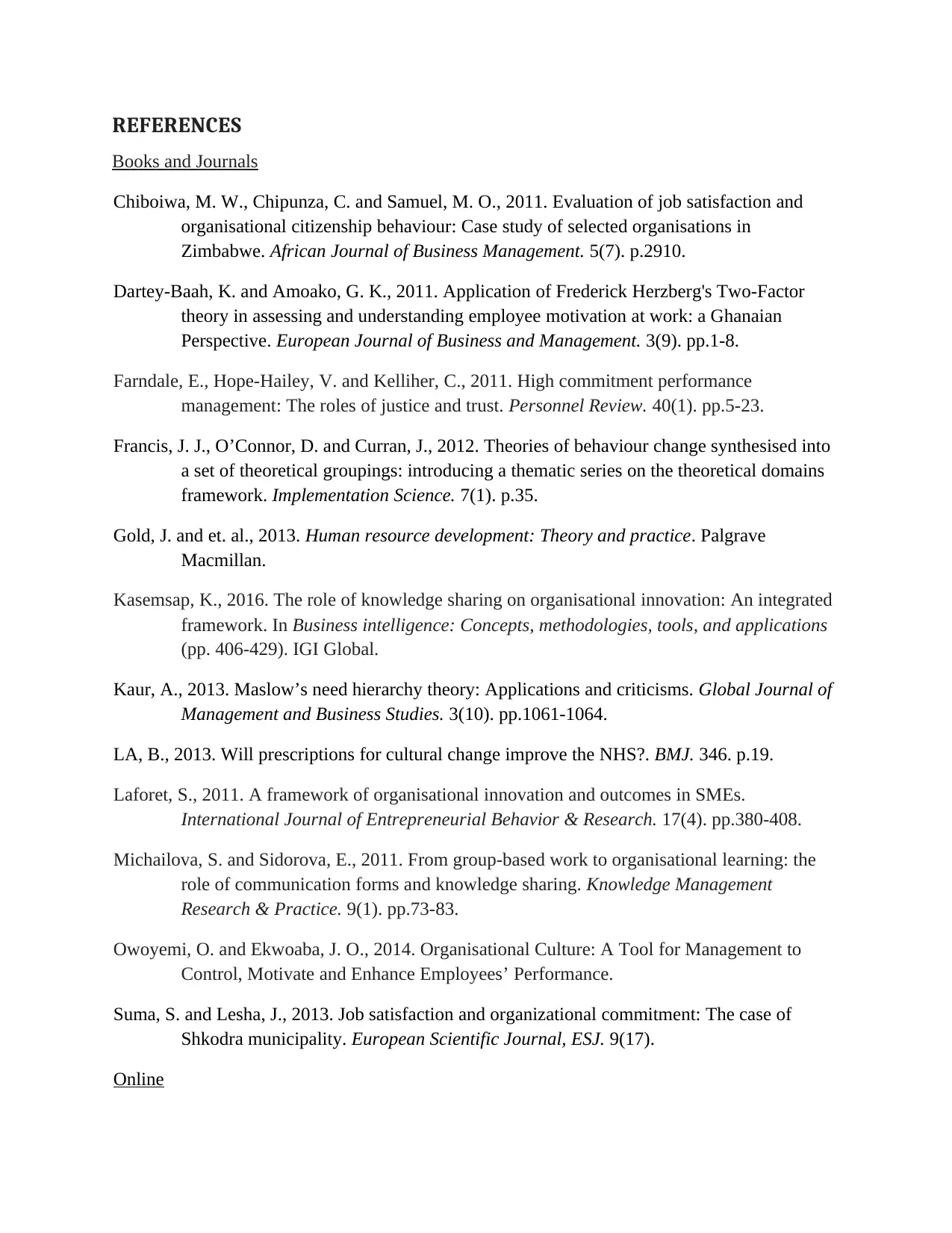
REFERENCES
Books and Journals
Chiboiwa, M. W., Chipunza, C. and Samuel, M. O., 2011. Evaluation of job satisfaction and
organisational citizenship behaviour: Case study of selected organisations in
Zimbabwe. African Journal of Business Management. 5(7). p.2910.
Dartey-Baah, K. and Amoako, G. K., 2011. Application of Frederick Herzberg's Two-Factor
theory in assessing and understanding employee motivation at work: a Ghanaian
Perspective. European Journal of Business and Management. 3(9). pp.1-8.
Farndale, E., Hope-Hailey, V. and Kelliher, C., 2011. High commitment performance
management: The roles of justice and trust. Personnel Review. 40(1). pp.5-23.
Francis, J. J., O’Connor, D. and Curran, J., 2012. Theories of behaviour change synthesised into
a set of theoretical groupings: introducing a thematic series on the theoretical domains
framework. Implementation Science. 7(1). p.35.
Gold, J. and et. al., 2013. Human resource development: Theory and practice. Palgrave
Macmillan.
Kasemsap, K., 2016. The role of knowledge sharing on organisational innovation: An integrated
framework. In Business intelligence: Concepts, methodologies, tools, and applications
(pp. 406-429). IGI Global.
Kaur, A., 2013. Maslow’s need hierarchy theory: Applications and criticisms. Global Journal of
Management and Business Studies. 3(10). pp.1061-1064.
LA, B., 2013. Will prescriptions for cultural change improve the NHS?. BMJ. 346. p.19.
Laforet, S., 2011. A framework of organisational innovation and outcomes in SMEs.
International Journal of Entrepreneurial Behavior & Research. 17(4). pp.380-408.
Michailova, S. and Sidorova, E., 2011. From group-based work to organisational learning: the
role of communication forms and knowledge sharing. Knowledge Management
Research & Practice. 9(1). pp.73-83.
Owoyemi, O. and Ekwoaba, J. O., 2014. Organisational Culture: A Tool for Management to
Control, Motivate and Enhance Employees’ Performance.
Suma, S. and Lesha, J., 2013. Job satisfaction and organizational commitment: The case of
Shkodra municipality. European Scientific Journal, ESJ. 9(17).
Online
Books and Journals
Chiboiwa, M. W., Chipunza, C. and Samuel, M. O., 2011. Evaluation of job satisfaction and
organisational citizenship behaviour: Case study of selected organisations in
Zimbabwe. African Journal of Business Management. 5(7). p.2910.
Dartey-Baah, K. and Amoako, G. K., 2011. Application of Frederick Herzberg's Two-Factor
theory in assessing and understanding employee motivation at work: a Ghanaian
Perspective. European Journal of Business and Management. 3(9). pp.1-8.
Farndale, E., Hope-Hailey, V. and Kelliher, C., 2011. High commitment performance
management: The roles of justice and trust. Personnel Review. 40(1). pp.5-23.
Francis, J. J., O’Connor, D. and Curran, J., 2012. Theories of behaviour change synthesised into
a set of theoretical groupings: introducing a thematic series on the theoretical domains
framework. Implementation Science. 7(1). p.35.
Gold, J. and et. al., 2013. Human resource development: Theory and practice. Palgrave
Macmillan.
Kasemsap, K., 2016. The role of knowledge sharing on organisational innovation: An integrated
framework. In Business intelligence: Concepts, methodologies, tools, and applications
(pp. 406-429). IGI Global.
Kaur, A., 2013. Maslow’s need hierarchy theory: Applications and criticisms. Global Journal of
Management and Business Studies. 3(10). pp.1061-1064.
LA, B., 2013. Will prescriptions for cultural change improve the NHS?. BMJ. 346. p.19.
Laforet, S., 2011. A framework of organisational innovation and outcomes in SMEs.
International Journal of Entrepreneurial Behavior & Research. 17(4). pp.380-408.
Michailova, S. and Sidorova, E., 2011. From group-based work to organisational learning: the
role of communication forms and knowledge sharing. Knowledge Management
Research & Practice. 9(1). pp.73-83.
Owoyemi, O. and Ekwoaba, J. O., 2014. Organisational Culture: A Tool for Management to
Control, Motivate and Enhance Employees’ Performance.
Suma, S. and Lesha, J., 2013. Job satisfaction and organizational commitment: The case of
Shkodra municipality. European Scientific Journal, ESJ. 9(17).
Online
Secure Best Marks with AI Grader
Need help grading? Try our AI Grader for instant feedback on your assignments.
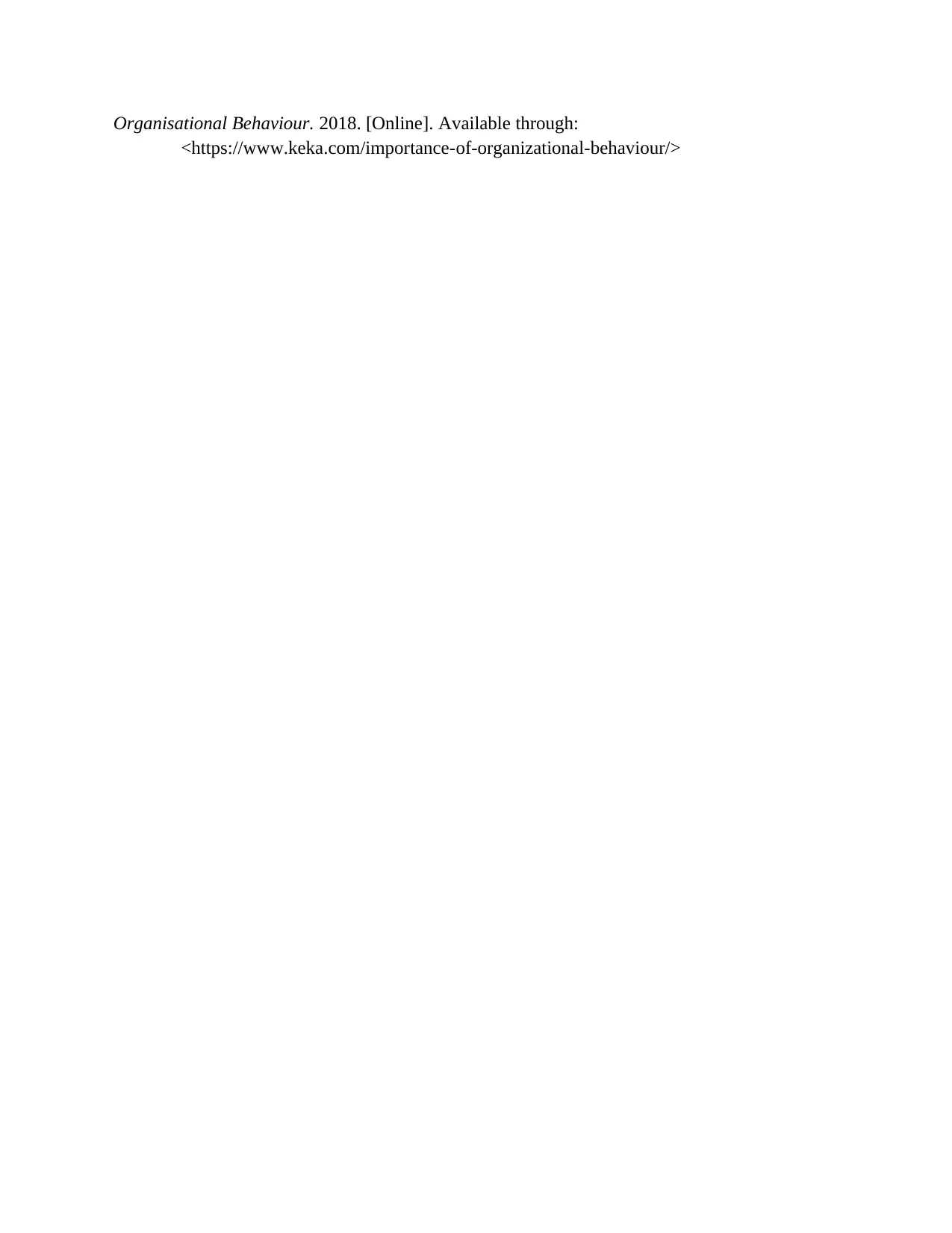
Organisational Behaviour. 2018. [Online]. Available through:
<https://www.keka.com/importance-of-organizational-behaviour/>
<https://www.keka.com/importance-of-organizational-behaviour/>
1 out of 11
Related Documents
Your All-in-One AI-Powered Toolkit for Academic Success.
+13062052269
info@desklib.com
Available 24*7 on WhatsApp / Email
![[object Object]](/_next/static/media/star-bottom.7253800d.svg)
Unlock your academic potential
© 2024 | Zucol Services PVT LTD | All rights reserved.





